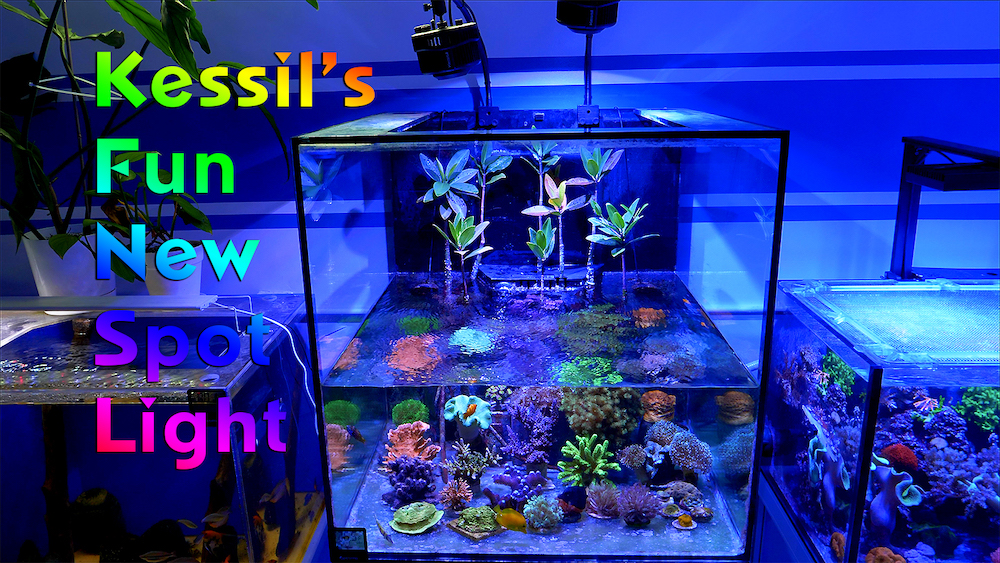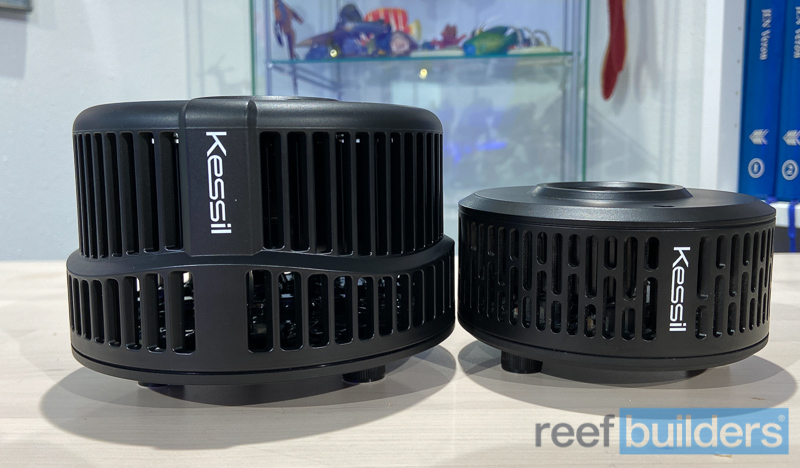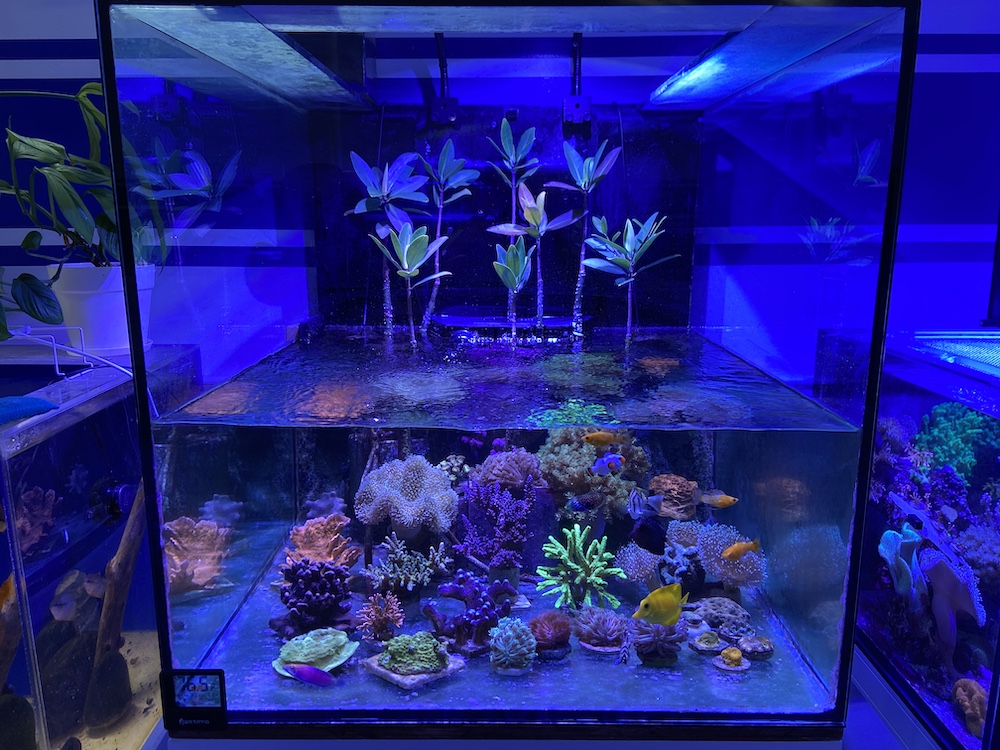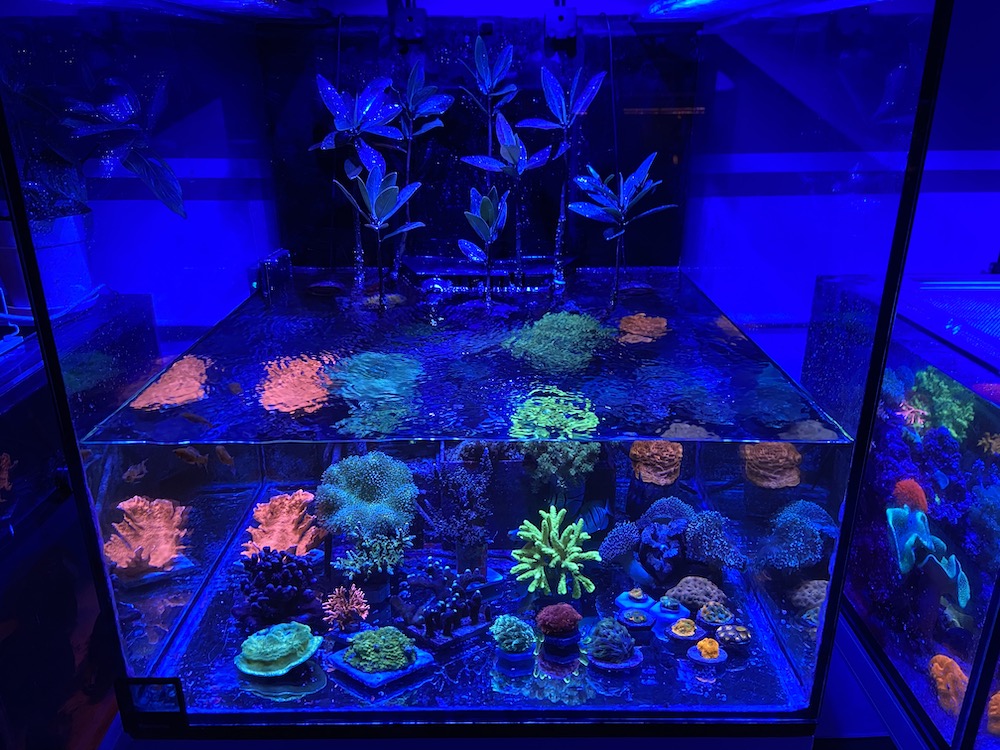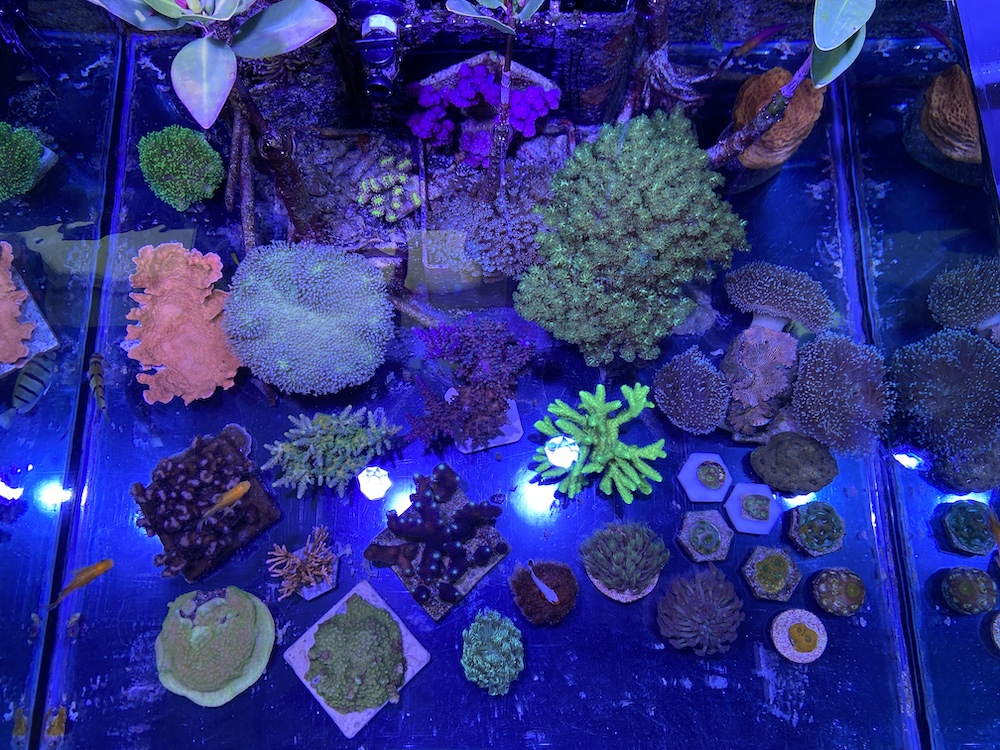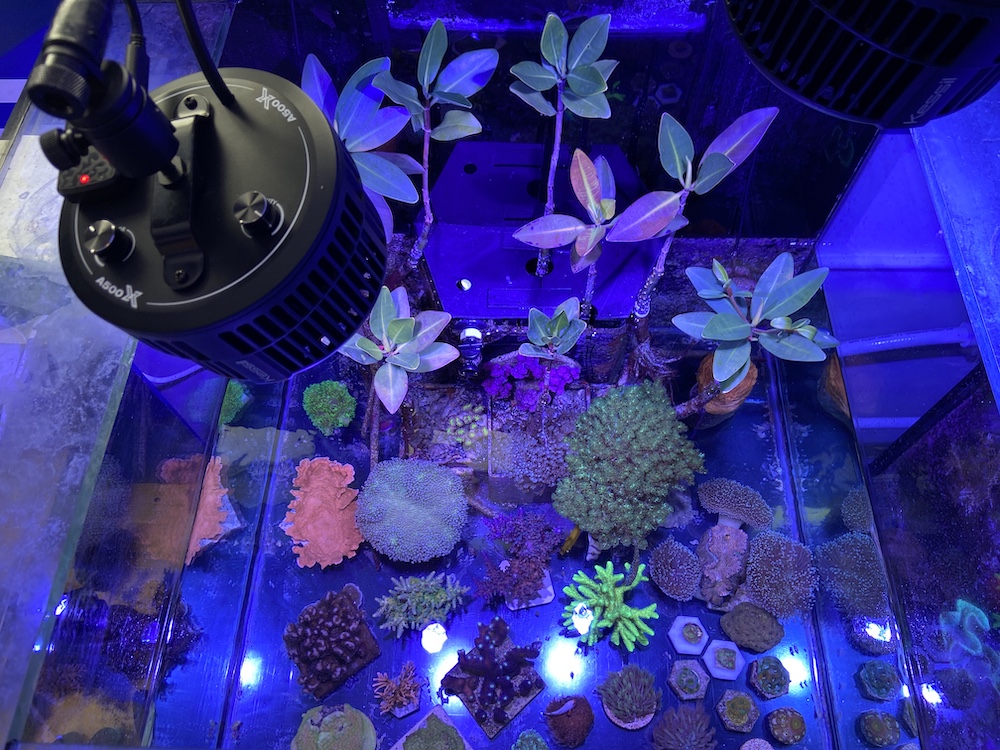The Kessil A500X is a brand new reef aquarium light that is packed with more power than we’ve ever seen in a spotlight form factor. From their earliest days, Kessil has come to define what is possible with light-emitting diodes emanating copious amounts of photons from a small point source but the Kessil A500X takes this to a whole new level.
Despite the model number, the Kessil A500X is twice as bright as the A360X and while the fixture itself might be twice the size of the A360X since this 90 watt light is already quite diminutive, the A500X ends up being roughly the same size as the legacy A360 (non-X). More so than any other light the smaller size is important to preserving the flexibility in mounting and placing this light over and around your tank, or even in between other more diffused sources of lighting.
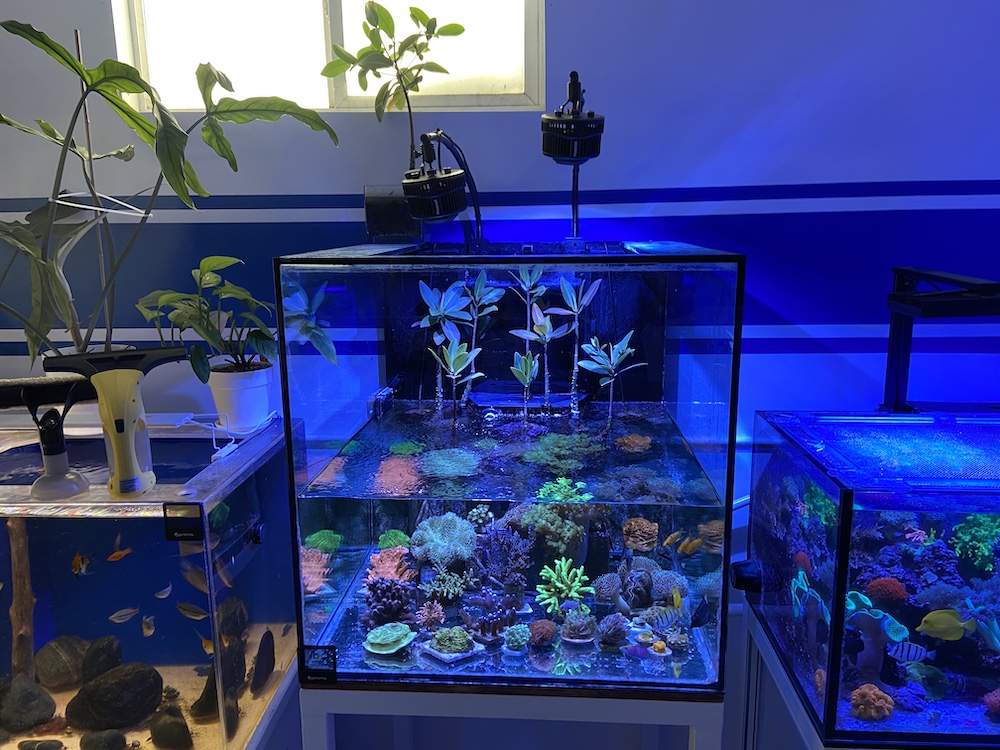
The details of Kessil lights’ form factor, control, and spectrum are already well known to many fans of the Kessil brands and the Kessil A500X is identical in all the most important ways. The Tuna Blue spectrum which shifts from all-white to all blue and everything in between is indistinguishable from the 15 watt A80 to the 185 watt AP9X so it’ll mix and match seamlessly with all of these fixtures.
The controls of the Kessil A500X are also exactly the same for both the manual onboard dials as well as the way in which the light is programmed with either the Kessil Spectral Controller, Wifi Dongle, as well as the way in which multiple lights can be daisy-chained together. All of the Kessil lights can work on their own but one thing that doesn’t get nearly enough mention is the fact that an additional controller is required to access the red, green, and purple color channels.
The baseline Tuna Blue spectrum is already quite flattering to aquarium animals with multiple shades of blue and deep blue that ranges from a sapphire blue for excellent brightness and color, but can also go deep blue-purple for a color that is the most similar to old school Actinic 03 lighting that we particularly love. The daylight end of the Tuna Blue spectrum is not a clinical, flat cool white either since it is closer to neutral white creating very bright light for driving the growth of SPS corals and light-hungry clams.
But if you want to get the most from the Kessil A500X you’ll need to unlock those accessory channels that really balances the daylight spectrum with red and green color channels, and that purple channels – with violet and indigo spectrum – has the near-UV for added fluorescent pop but it does wonders for making pink and purple corals really stand out. If you’re a fan of the spectrum from previous generation Kessil lights, the A500X really doesn’t leave anything out and never leaves us wanting for any additional color supplementation.
The spectrum of Kessil’s lights is an old trick but the newest and most important feature of the Kessil’s newest lights from the A360X to the AP9X – and now the A500X – is their formula for lighting efficiency. It’s basic physics that LEDs are most efficient at lower drive currents so the more LEDs you have in a fixture for a given power, the more light it will produce at a given wattage.
It’s not economically feasible to populate a light fixture with thousands of diodes to get radically high efficiency, but some manufacturers have been trying to manage cost vs. efficiency, not to mention balancing the separate control channels which each require a dedicated driver. Kessil is among the few light manufacturers that have managed to balance this delicate equation with 100 LEDs running at less than two watts each resulting in industry-leading light output.
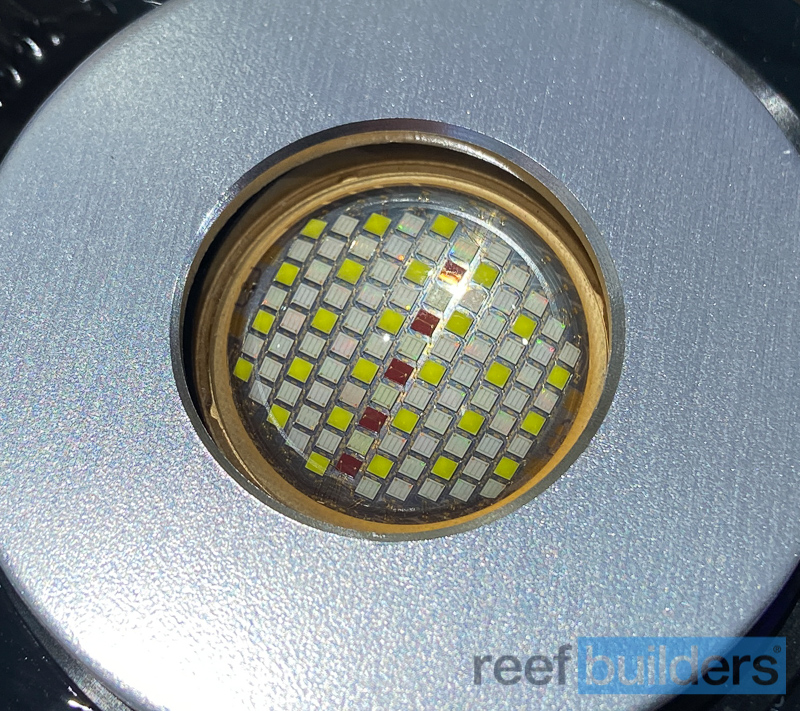
The thing about having so much lighting power coming from such a small point source creates a challenge but also a new opportunity for shaping the output, something we haven’t had to do in a really long time since metal halides were the norm for aquarium lighting. Some reefers will justifiably be leery of working with a point source of aquarium lighting, especially when the current lighting landscape is leaning increasingly towards ever more diffused and spread-out panels of LED light.
Kessil released the 55-degree magnetic reflector for the Kessil A360X which also works with the A500X, but with this new more powerful light Kessil also released an all-new 35-degree magnetic reflector, which is also backward compatible with the A360X. 35 degrees might not seem like a big difference from the previous 55 degrees but it’s just a little over half the spread of the 55-degree reflector or less than a third of the 120 beam angle without any reflector, so there’s a lot of room there to play with and manipulate the light output.
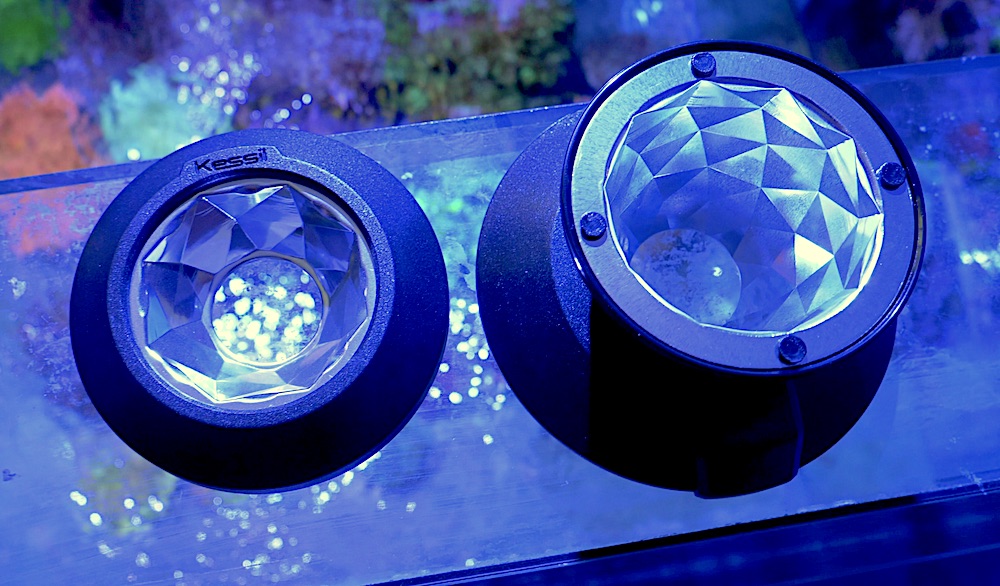
These secondary reflectors do wonders for concentrating the light into the aquarium, especially for deep tanks but it doesn’t really change the point-source nature of the Kessil A500X, unless you are really mindful of how the light can bounce off the glass of the aquarium walls. From the many studies of metal halide reflectors and their spread, we believe there’s still room for a wider reflector that could be less ‘punchy’ but help manage the light and turn it into less of a point source.
A wider reflector isn’t in the cards yet so we’ve already experimented a little bit at making our own with a modified steel pet bowl – it’s not the greatest but there’s still all kinds of room for improvement. But that’s the beauty of a point source light, it’s like a firehose of light ‘flow’ whose output can be shaped and manipulated, but you can’t really say the same for more diffused light sources that do a great job at spreading out the light, but they can’t really be fine-tuned for anything else.
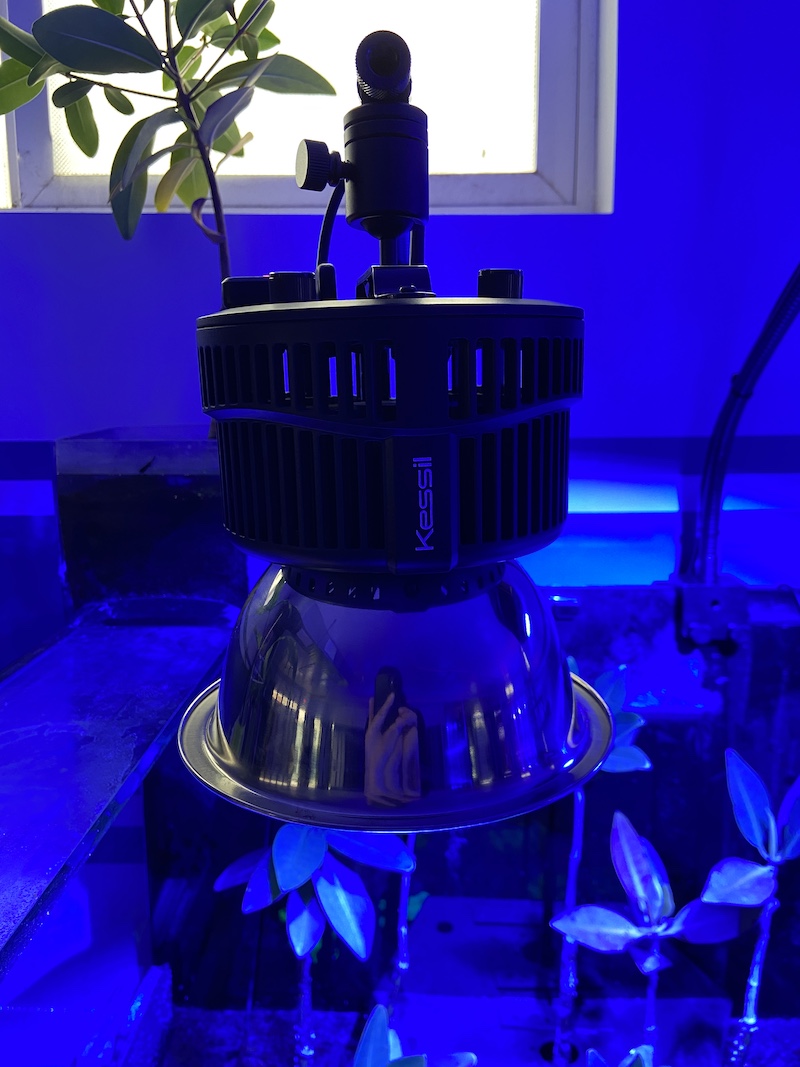
By now you’re probably starting to get the impression that the Kessil A500X is more of a professional light and we wouldn’t recommend it for anything but the largest and deepest of tanks, or the most light-demanding of corals and clams. In order to demonstrate the power and flexibility of Kessil’s 185 watt spotlight, we decided to use it over out mangrove lagoon aquarium which is probably one of the trickiest displays we’ve ever tried to illuminate.
The tank is around 33 inches cubed and is half-filled with water so we can’t count on internal reflection from the aquarium walls to help distribute and bounce the light to help mitigate the point source. A single A500X is plenty bright enough to light up the entire aquarium but it’s this lack of internal reflection that has led us to use two Kessil A500X lights so we can have some overlap of the lighting over our three-dimensional corals.
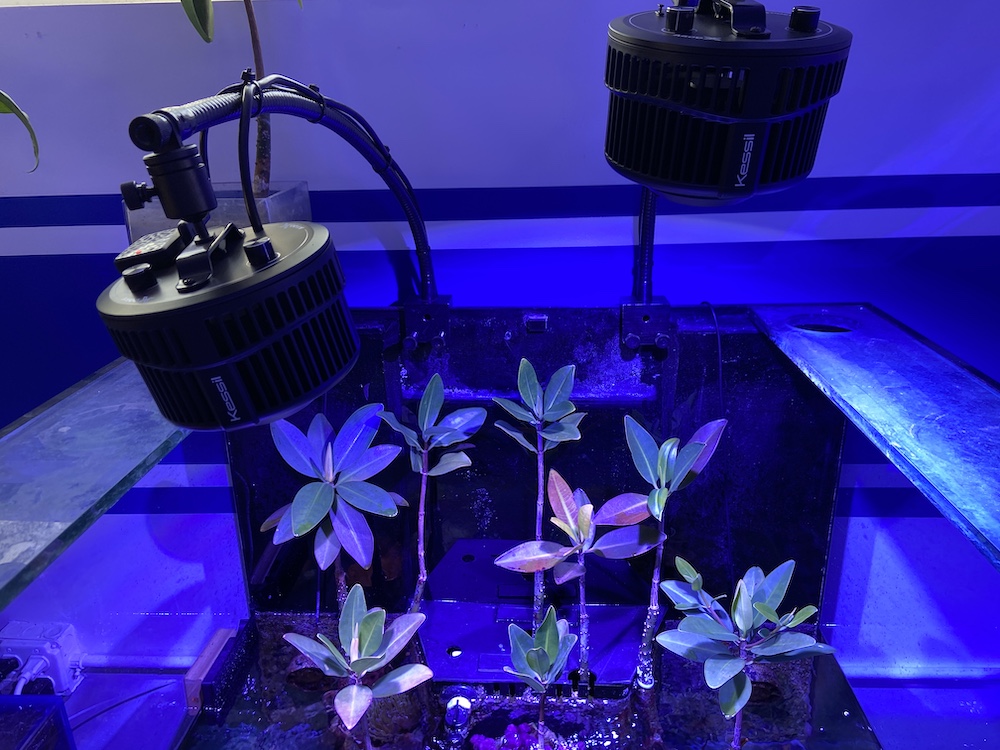
Furthermore, the mangrove lagoon has light hungry mangrove trees with a canopy of leaves towards the top, clams and SPS corals on the bottom which are similarly light hungry, and wide range of assorted corals in between to help demonstrate the rendition of most colors found in reef aquarium displays. It goes without saying that trying to keep all these light-demanding corals and trees happy from the top to the bottom of the tank is an interesting lighting challenge.
But one thing that is a little easier to overlook is that we mounted the Kessil A500X more than three feet or 90cm above the bottom of the tank where we have an assortment of Acropora, Stylophora, Heliopora, Hydnophora, and clams all growing on the bottom, with the wider 55-degree reflector no less! Once again we wanted to demonstrate what is possible using the Kessil A500X using the reflector that most people are familiar with, but we are very excited to start experimenting with the more focused narrow beam reflector.
The only thing really holding back the A500X is the mounting options because a more powerful light simply needs more freedom of mounting height above the aquarium to really take advantage of the light output, especially with the more focused reflector. The current ~5/8th inch gooseneck can support the weight of the A500X, but it’s not long or strong enough for real placing versatility. The rigid mounting arm is probably tall enough for most tanks but it simply doesn’t extend out far enough to get the kind of front-facing light coverage that makes for *premium* coral and reef tank presentation.
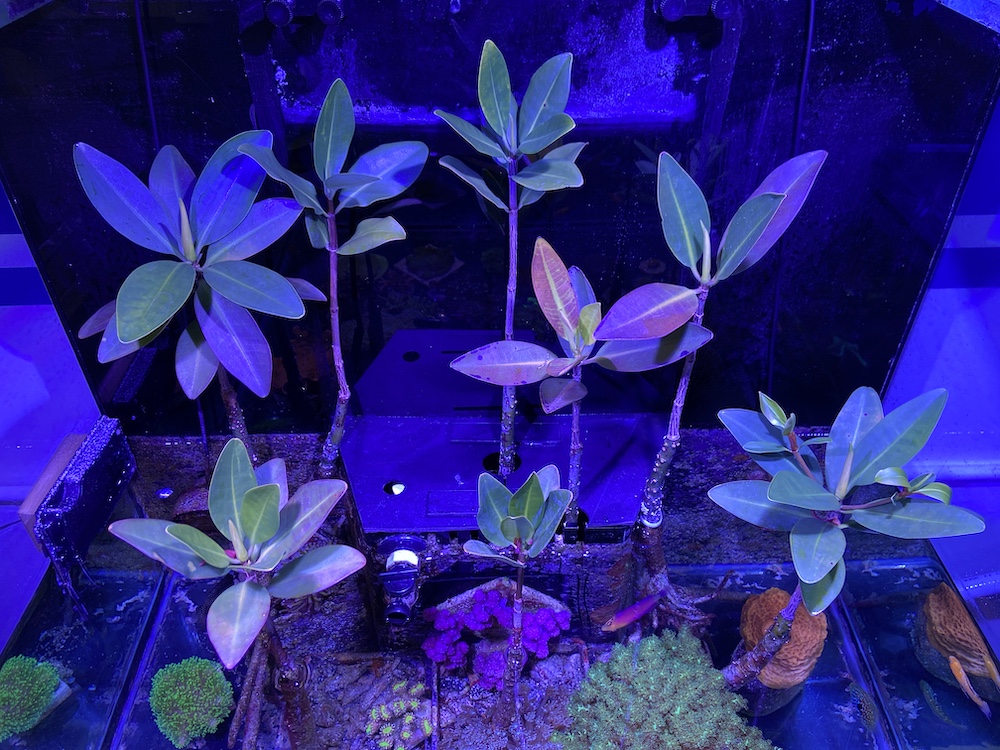
We’ve already covered a lot about the features and specifications of the Kessil A500X in our hands-on article and deeper dive of the standalone hardware and we also talked about it in one of our earliest sessions of the Reef Therapy podcast. Without hesitation, the intense point-source lighting of the A500X spotlight is the most similar we’ve ever seen to metal halide lighting, both with the opportunities and challenges that poses for lighting up our reef aquariums.
Without hesitation, we can say that the nearly 200 watts of concentrated power is not for most aquariums, but it will find a unique place in creative aquarium displays such as ours, on larger and deeper tanks, and for sure the public aquariums are going to eat these lights up. We illustrate many of the points highlighted above in our latest review video of the Kessil A500X but for sure there’s still plenty of testing and experimentation that users will need to play around with in order to unlock some of the more original ways that this light can be used.
If you’re located in the United States you can purchase the light from our Retail partner Premium Aquatics.
Superior Illumination
Coverage – The newly designed A500X optics along with the latest generation Dense Matrix LED array to provide a broad delivery of light and eliminate shading.
Spectrum – The well-known Tuna Blue spectrum has been proven by its users to promote coral growth and enhance coloration. With Kessil Logic, it ensures consistent power output and coral growth across the tunable spectrum.
Shimmer – The Kessil shimmer effect gives your tank a beautiful, natural, sunlit look comparable to the shimmer of a Metal Halide fixture. It is like replicating your own piece of the ocean.
Penetration – Kessil’s Patented Dense Matrix LED technology concentrates multiple LED chips into a single array, creating a powerful and penetrating light source with wide coverage. The standard 110 degree reflector can reach 24″ beyond the water’s surface in most reefs. Penetration can be further enhanced by using the narrow 55 or 35 degree reflectors, reaching as far as 4 feet below the surface.
Color Mixing – Different wavelengths are seamlessly blended within a single LED array, emitting uniform color across the coverage range, and reducing individual color separation to almost nothing.
Design
Full-Color Spectrum – In addition to the popular Tuna Blue spectrum, users can add in Red, Green, and Purple (Violet+Indigo) by using the new Spectral Controller X or the Kessil WiFi Dongle.
Heat Management – The innovative heat management system enhances longevity and efficiency on all A500X lights
Dense Matrix LED – Kessils densely-packed LED array emits more high-quality light than competing fixtures.
Control
Wireless – The Kessil WiFi Dongle lets you control any A500X light without the need of additional cords or hardware. The WiFi Dongle will plug right into the K-Link connector and let you connect directly to the light with any Android or iOS phone. The intuitive app boasts a ton of features that lets you do everything from daily automated programming to manual programming for photoshoots or just showing off your reef tank.
Hardwired – The Kessil Spectral Controller X is packed with features that let you simulate the natural rise and fall of the sun throughout the day. You do not necessarily need the Spectral Controller X, but adding it to your A500X lights will unlock additional features and modes that give you endless customization of the lights for your aquarium. You can even connect multiple Kessil A500X LED Lights together for larger tanks with the K-Link Cable to create a seamless day-cycle between all the lights.
Technical Specifications
- Dimensions: 3.7″ x 5.2″ / 9.4cm x 13.3cm
- Unit Weight: 1.72lb / 0.78kg
- Spectrum: Tuna Blue + Red + Green + Purple
- Power Adapter: 100-240V AC 50-60Hz (input), 48V DC (output)
- Power Consumption: AC 185W max
What’s Included?
1x A500X Tuna Blue
1x Power Adapter
1x AC Adapter Cable
1x Hanging Ring
2x Metal Screw Hook
2x Hanging Bracket
1x 55 degree Reflector


